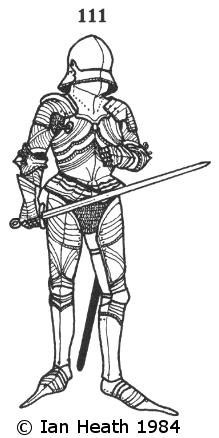
Amazon Audible Gift Memberships
GERMAN MAN-AT-ARMS c.1480
An extract from Armies of the Middle Ages, Volume 2by Ian Heath



111. GERMAN MAN-AT-ARMS c.1480
Probably one of the most widely reproduced suits-of-armour in the world, this full plate harness of Archduke Sigmund of Tyrol is the very epitome of German 'High Gothic' armour, with virtually every piece being decoratively ripple-fluted. As can be clearly seen, the deep fauld of 110 has diminished over the intervening decades until it now comes only just below the hips, a stage in its evolution that had been reached by as early as the 1460s. The breastplate had by this time similarly evolved as mentioned above, and was now strengthened by a two-piece plackart, connected at its apex to the bevor. His helmet is a sallet, called a Tschelern in Germany at the time of its first recorded appearance there in 1425, this becoming in time Schallern, the name probably originally deriving either from Schale (shell) or from a corruption of Italian celata (from which type of helmet it may have evolved). Indeed, the very first sallets in Germany were seemingly imported from Italy. They only begin to appear in contemporary pictures during the 1440s, and even then remained uncommon until the 1460s, thereafter becoming the predominant type of helmet to be found amongst German men-at-arms. Some were left unpolished, being called 'black sallets' as a result; surviving examples of this type are often painted or fabric-covered instead.